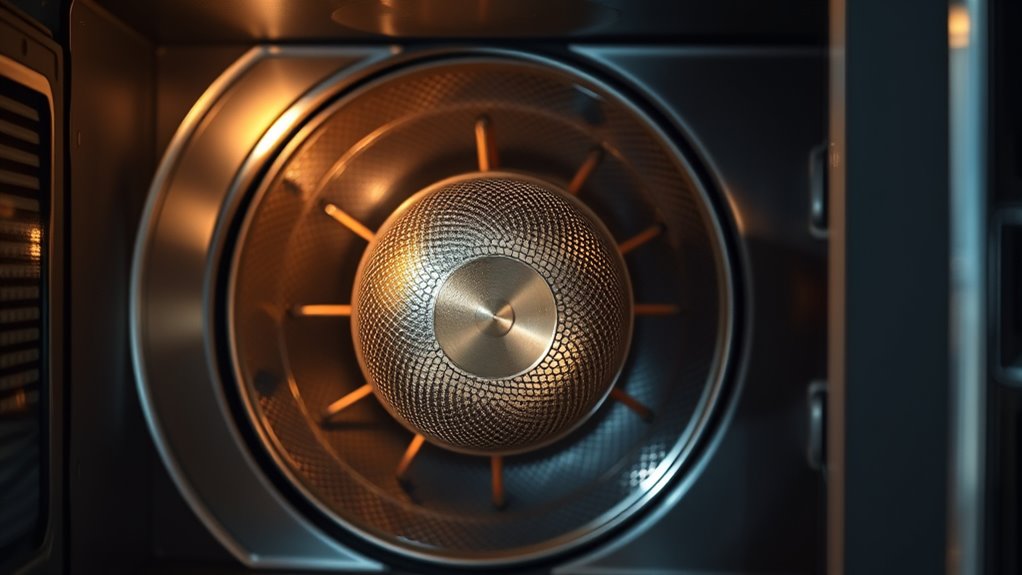Your microwave oven is powered by a device called a magnetron. It converts electrical energy into high-frequency microwaves by using a heated cathode and magnetic fields to produce electron oscillations. These oscillations excite resonant cavities, creating microwave radiation that heats your food quickly and efficiently. The design and resonance qualities of the magnetron guarantee stable microwave output. To discover more about how this fascinating component works, keep exploring its inner workings and history.
Key Takeaways
- The magnetron generates microwave radiation by resonating cavity structures that produce high-frequency electromagnetic waves around 2.45 GHz.
- It contains a heated cathode that emits electrons, which are guided by magnetic and electric fields to excite the cavities.
- Electron-cavity interactions sustain oscillations, amplifying microwave energy used for cooking in microwave ovens.
- Power is controlled by adjusting the magnetron’s on/off cycle or using inverter systems to vary microwave output.
- Safety features and shielding prevent microwave leakage, ensuring the magnetron safely powers your oven’s heating process.
What Is a Magnetron and How Does It Function?
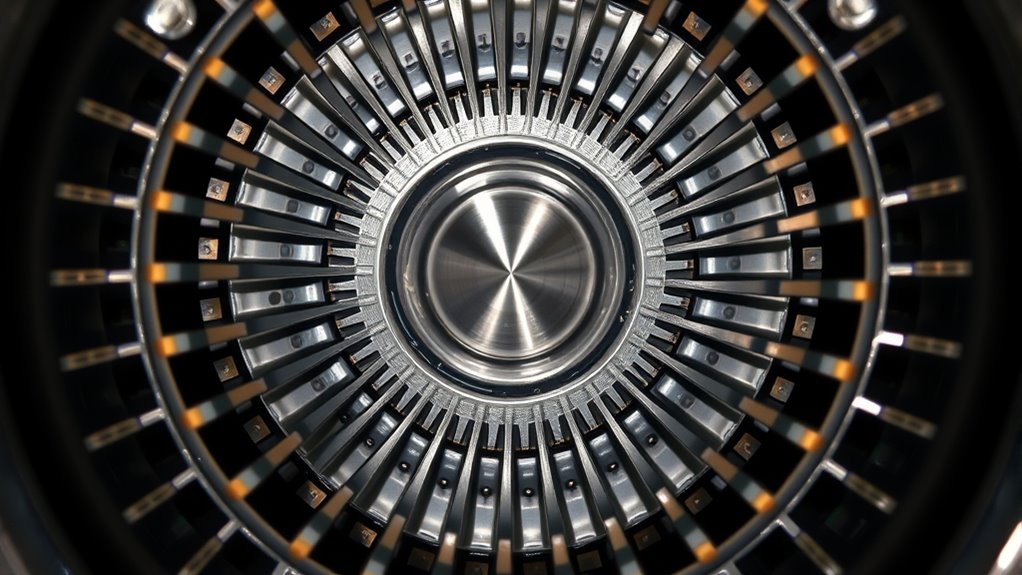
Ever wonder how microwave ovens produce the waves that heat your food? It all starts with a device called a magnetron, which generates microwave radiation through resonating cavity resonators. Inside, a heated cathode releases electrons, while a ring-shaped anode guides them. The magnetic field along the magnetron causes these electrons to spiral, creating a dynamic interaction with the electric field. This interaction produces oscillations at microwave frequencies, typically between 1mm and 30cm, depending on the cavity dimensions. These electromagnetic waves are generated as electrons move within the magnetic and electric fields inside the magnetron. The design guarantees a consistent microwave frequency, which is then directed into your oven to heat food efficiently. That’s how a magnetron powers your microwave and makes your meals hot. Additionally, understanding the oscillation process can help appreciate the precise engineering behind microwave technology.
The Inner Design of a Cavity Magnetron

The inner design of a cavity magnetron centers on its cylindrical metal chamber, which houses multiple resonant cavities arranged around its rim. These cavities are vital because their size and shape directly determine the resonant frequency, typically around 2.45 GHz for household ovens. Inside the chamber, a heated cathode emits electrons, which spiral under the influence of a magnetic field, interacting with the cavities. The cavities act as LC circuits, amplifying microwave oscillations when excited by these electrons. Short channels connect the cavities, enabling energy transfer and resonance. The anode contains slots and cavities that facilitate coupling of the microwave energy into a waveguide, which then transmits the generated microwave radiation into the oven cavity for cooking. Understanding the magnetron tuning process is essential for optimizing oven performance and efficiency. Additionally, cavity dimensions are carefully engineered to ensure maximum energy transfer and minimal power loss during operation, which directly impacts the overall interior effectiveness of microwave cooking. Recognizing the importance of resonant cavities helps in understanding how the magnetron maintains stable and efficient microwave generation, especially as resonant frequencies can be affected by temperature changes and component aging.
How Magnetrons Generate Microwave Radiation
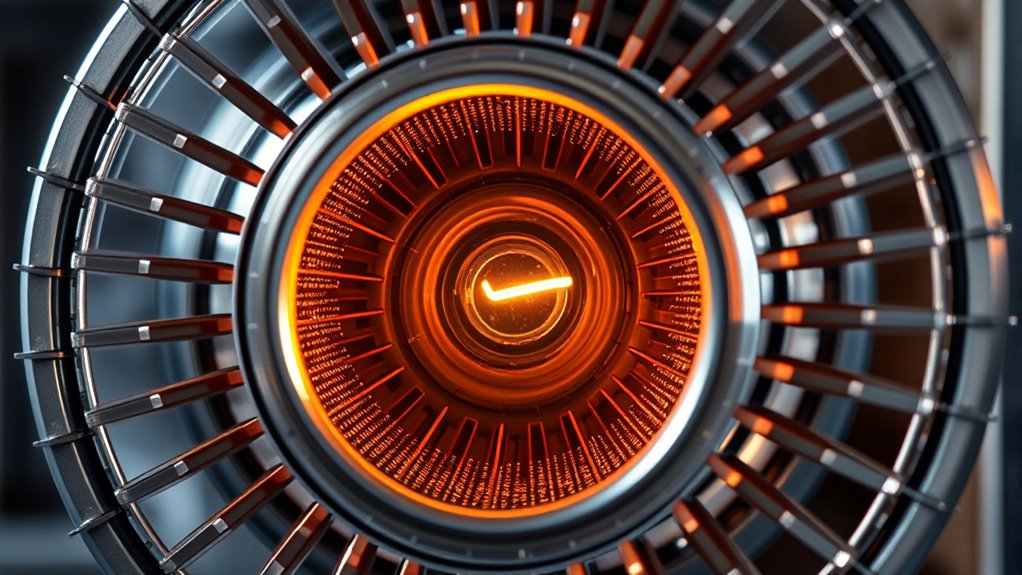
How do magnetrons produce microwave radiation? Inside the device, a heated cathode emits electrons, which are then influenced by a strong magnetic field, causing them to spiral along curved paths. As these electrons move, they pass through the anode containing resonant cavities. These cavities vibrate at microwave frequencies when impacted by the electrons, converting electrical energy into microwave radiation. The process involves:
- Electrons spiraling in response to the magnetic field, creating oscillations.
- Passing through resonant cavities that amplify specific microwave frequencies.
- Impacting the cavities, which induce oscillations at a resonant frequency determined by their size, generating stable microwave energy.
- Both the magnetic field and resonant cavities work together to produce efficient microwave generation, making the magnetron a powerful transmitter of microwave energy. Additionally, the design of the cavities is critical for frequency stability, ensuring consistent microwave output.
The Physics Behind Magnetron Resonance
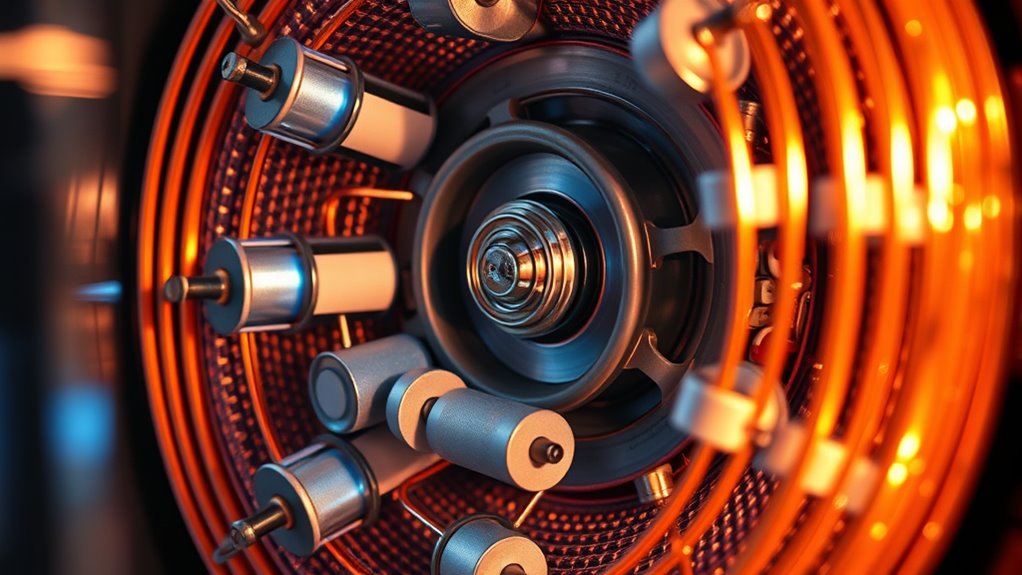
You can understand magnetron resonance by looking at how electron trajectories interact with magnetic and electric fields, causing them to spiral and generate oscillations. The cavity dimensions are tuned to match the natural resonant frequency, which amplifies the microwave output. This resonance is sustained as the cavity continuously feeds energy back into the system through these electron-cavity interactions. Additionally, understanding the resonant frequency helps in designing more efficient microwave ovens and other resonant devices. Proper maintenance of the magnetron, including ensuring clean filtration, can also improve resonance stability and performance. Techniques like electromagnetic tuning are employed to optimize resonance conditions for better efficiency.
Electron Trajectories and Fields
Electrons emitted from the heated cathode are influenced by both electric and magnetic fields, causing them to follow curved, often cycloidal, paths rather than moving straight toward the anode. The electric field from the anode pushes electrons outward, while the magnetic field, aligned with the magnetron’s axis, deflects them into circular or spiral trajectories. To visualize this:
- Picture electrons spiraling like tiny planets caught in invisible gravitational pulls.
- Imagine the magnetic field acting as a force that makes electrons curve away from a straight line.
- Envision the combined electric and magnetic forces guiding electrons through resonant cavities, creating oscillations that generate microwave energy. This interaction of electromagnetic forces is fundamental to the operation of the magnetron, enabling efficient microwave production. Additionally, the development of advanced electromagnetic theories has enhanced our understanding of these complex interactions. Understanding these electromagnetic interactions allows engineers to optimize the magnetron’s design for better performance and energy efficiency. Recognizing the importance of magnetic flux helps in designing more effective magnetron systems. This interplay of electric and magnetic fields shapes the electrons’ paths, essential for producing microwaves in your oven. Understanding electromagnetic forces is key to grasping how the magnetron operates effectively.
Cavity Resonance and Oscillation
The movement of electrons within the magnetron’s resonant cavities causes the cavities to oscillate at specific microwave frequencies. Cavity resonance occurs when the shape and size of these metal chambers align with the natural frequency of the oscillating electrons, acting like tiny LC circuits. As electrons pass through, their interaction excites the cavity walls, leading to sustained oscillation at microwave wavelengths, typically between 1mm and 30cm. This resonance amplifies microwave radiation, with the oscillations maintaining a consistent frequency. However, factors like load impedance, temperature, and supply current can slightly shift the cavity resonance, influencing the stability of the emitted microwaves. Cavity resonance depends on the precise dimensions and material properties of the resonant chambers, which are engineered to optimize microwave generation. Additionally, the cavity shape is carefully designed to support the desired oscillation modes, enhancing the efficiency of microwave production. Changes in material properties can affect the resonance stability and efficiency of the magnetron, making material selection crucial for optimal performance. Furthermore, understanding the power supply effects on cavity resonance can assist in maintaining consistent microwave output. Understanding this resonance helps explain how the magnetron generates the high-frequency signals that power your microwave oven. A thorough knowledge of resonant frequencies can also aid in troubleshooting and improving microwave design for better efficiency.
Key Historical Milestones in Magnetron Development

The development of magnetrons has a rich history marked by key innovations and breakthroughs. Early inventors laid the groundwork, while World War II advancements dramatically increased their power and efficiency. These milestones transformed microwave technology and expanded its practical applications. Additionally, ongoing improvements in sound recording techniques continue to enhance the quality and versatility of microwave devices today.
Early Innovations in Magnetrons
Early innovations in magnetrons laid the groundwork for microwave technology, with key milestones emerging over the first half of the 20th century. You can imagine the first magnetron invented by Hans Gerdien in 1910, sparking the quest for high-frequency signals. Then, in 1912, Heinrich Greinacher created models that used crossed magnetic and electric fields, generating high-frequency signals essential for microwave development. By 1921, Albert Hull was working on controlling electron flow with magnetic fields to develop magnetrons, bypassing patents and advancing the technology. Picture the 1924 discoveries by August Žáček and Erich Habann, who independently demonstrated microwave generation with magnetrons. These early innovations laid the foundation for the high-power cavity magnetron perfected during WWII, a pivotal step in microwave technology.
WWII Breakthroughs and Impact
During World War II, the development of the cavity magnetron marked a major breakthrough that transformed radar technology. This invention, created in 1940 by Sir John Randall and Harry Boots, produced initial prototypes of around 400 watts, later reaching 25 kilowatts. The increased power considerably boosted radar detection, giving the British a strategic advantage. Researchers like James Sayers improved frequency stability by coupling cavities, enhancing the magnetron’s performance. The GEC company produced 12 prototype magnetrons in August 1940, accelerating wartime advancements. This breakthrough enabled more precise targeting and detection during WWII. The magnetron’s impact extended beyond military use, laying the foundation for microwave technology used in everyday appliances today.
| Year | Development Milestone | Impact |
|---|---|---|
| 1940 | Magnetron invention | Boosted radar capabilities |
| 1940 | Prototype production | Rapid technology advancement |
| 1940 | Power increase | Improved detection |
| 1940 | Frequency stabilization | Enhanced performance |
| WWII | Strategic advantage | Changed warfare tactics |
Practical Uses of Magnetrons in Modern Technology

Magnetrons play a vital role in various modern technologies by generating high-power microwave radiation that serves many practical purposes. You’ll find magnetrons in microwave ovens, where they heat food efficiently through dielectric heating. In radar systems, they produce pulsed microwave signals that help detect targets and map terrains. They’re also used in microwave lighting systems, like sulfur lamps, to excite gases for illumination. Additionally, magnetrons are essential in industrial microwave processing, powering tasks such as drying, curing, and sterilization. Imagine:
Magnetrons are essential for microwave ovens, radar, lighting, and industrial processing.
- Microwave ovens, rapidly heating your meals.
- Radar systems guiding ships and aircraft.
- Industrial plants sterilizing equipment efficiently.
These applications highlight how magnetrons enable modern technology, making processes faster, safer, and more reliable.
Power Control in Microwave Ovens Using Magnetrons
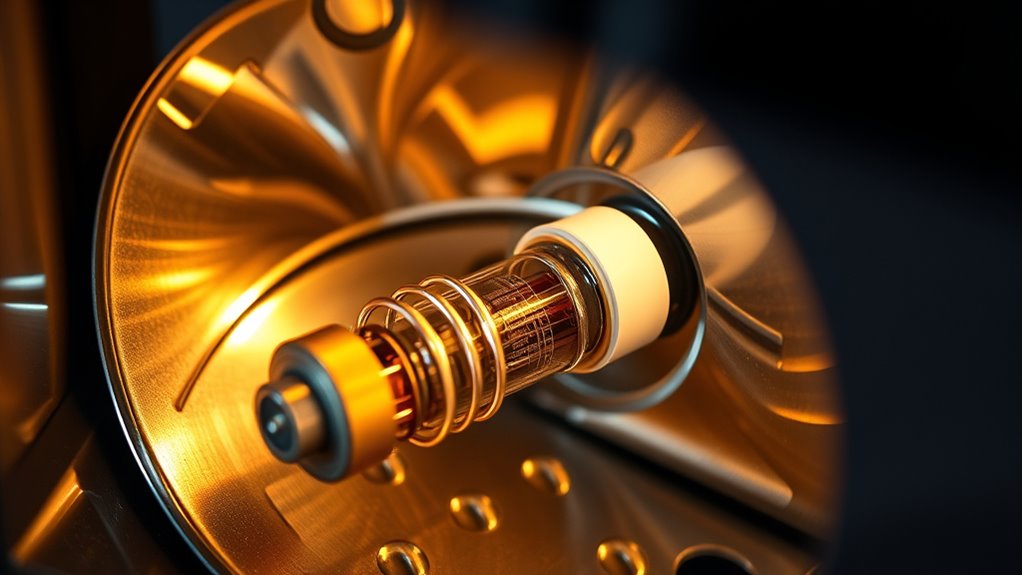
Power control in microwave ovens relies on manipulating how the magnetron operates, since its frequency remains largely fixed. Most traditional models turn the magnetron on and off rapidly, creating a duty cycle that reduces the average power delivered to your food. By increasing the off time, you lower the overall heat without changing the magnetron’s output power directly. Inverter-based systems, however, use high-frequency electronic circuits to vary the magnetron’s power continuously, allowing for more precise temperature control. Although the frequency stays steady, adjusting the duration of active and inactive periods effectively manages the power supplied. Some advanced ovens even modulate power by changing filament current or magnetic field strength, influencing the magnetron’s oscillation amplitude for finer control.
Safety Considerations and Future Advances
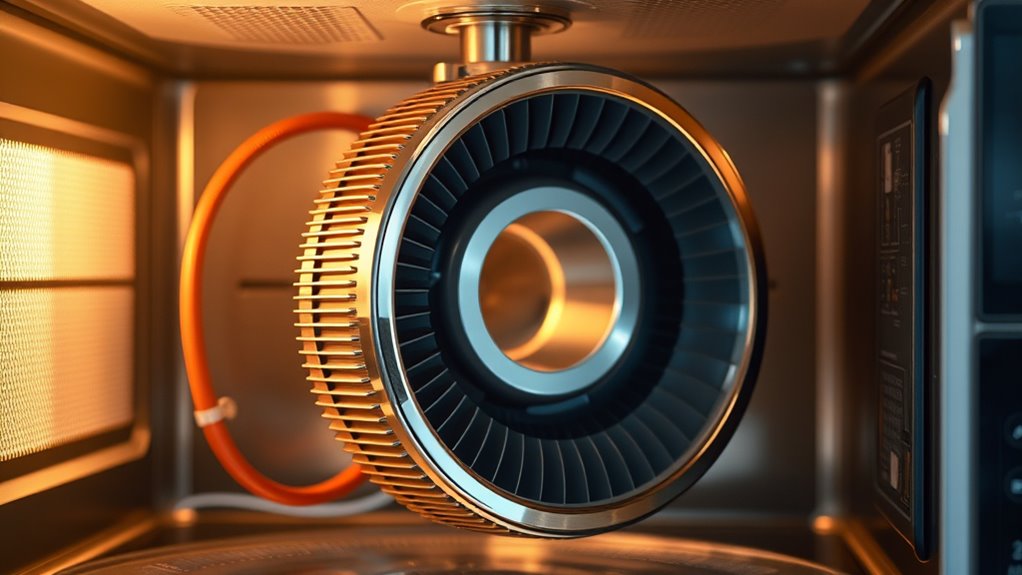
Safety remains a critical aspect of microwave oven design, as high-power microwave radiation must be carefully contained to prevent harm. To guarantee your safety, modern ovens feature key safety measures such as:
- Robust shielding and interlocks that stop microwave emission if the door opens.
- Leakage detection sensors that monitor for any microwave escape.
- Automatic shutoff systems that activate if safety parameters are breached.
These innovations protect you from exposure to microwave radiation emitted by magnetrons, which operate at around 2.45 GHz. Future advances aim to improve magnetron efficiency, reduce electromagnetic interference, and further enhance safety standards. By focusing on these developments, manufacturers continue to make microwave ovens safer and more environmentally friendly, giving you peace of mind during use.
Frequently Asked Questions
How Does a Microwave Oven Magnetron Work?
You might wonder how a microwave oven’s magnetron works. It heats food by generating microwaves through a process where electrons are emitted from a heated cathode and spiral within a magnetic field. These electrons cause resonant cavities to vibrate at specific frequencies, producing microwave radiation. This energy is then directed into the oven, where it excites water molecules in your food, heating it quickly and efficiently.
What Powers a Microwave Oven?
You wonder what powers your microwave oven. It uses a high-voltage transformer that supplies around 4,000 volts, which energizes the magnetron. The magnetron, powered by this electricity, emits microwave radiation that heats your food. This device operates as a self-oscillating component, creating the microwaves needed for cooking. The transformer and magnetron work together to generate the energy that makes your microwave heat efficiently.
What Is the Power of the Magnetron in a Microwave Oven?
The power of the magnetron in your microwave is like a superhero’s strength, usually ranging from 700 to 1,000 watts. This magnetron converts electrical energy into microwave radiation to heat your food efficiently. While higher wattage means faster cooking, it also uses more energy. Most household models operate with magnetrons around 700-1,000 watts, providing a perfect balance of power and energy consumption for everyday use.
What Is the Power Factor of a Microwave Oven?
You’re curious about the power factor of a microwave oven. Typically, it ranges from 0.6 to 0.9, showing how efficiently the appliance uses electrical energy. A lower power factor means more reactive power, making current out of phase with voltage. Many microwaves have a power factor around 0.7 to 0.8, so understanding this helps you gauge their energy efficiency and optimize usage.
Conclusion
So, next time you heat your leftovers, remember—you’re witnessing the incredible power of a magnetron, a tiny miracle that turns electricity into microwave magic. It’s like having a supercomputer in your kitchen, blasting invisible waves with unstoppable force. Without this tiny titan, your popcorn wouldn’t pop, your coffee wouldn’t brew, and your meals wouldn’t warm in seconds. It’s nothing short of a modern marvel—the heart of your microwave’s unstoppable, electrifying magic!
